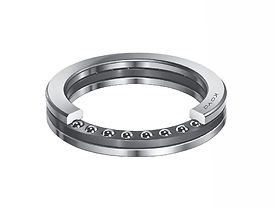
PRODUCTS
Deep Groove Ball
Bearings
The most widely used roller bearing type in the world due to their versatility and overall performance. They are characterized by having deep raceway grooves in which the inner and outer rings have circular arcs of a slightly larger radius than that of the balls. They also have non-separable rings.
Cylindrical Roller
Bearings
Cylindrical Roller Bearings are designed to carry heavy loads—the primary rolling element is a cylinder, which means the load is distributed over a larger area, enabling the bearing to handle larger amounts of weight. This structure, however, means the bearing can handle primarily radial loads, but is not suited to thrust loads. For applications where space is an issue, a needle bearing can be used. Needle bearings work with small diameter cylinders, so they are easier to fit in smaller applications.
Needle Roller
Bearings
A needle roller bearing is a special type of roller bearing that uses long, thin cylindrical rollers resembling needles. Ordinary roller bearings rollers are only slightly longer than their diameter, but needle bearings typically have rollers that are at least four times longer than their diameter.
Tapered Roller Bearings
Tapered angles allow the bearings to efficiently control a combination of radial and thrust loads. The steeper the outer ring angle, the greater ability the bearing has to handle thrust loads. To provide a true rolling motion of the rollers on the raceways, the extensions of the raceways and the tapered surfaces of the rollers come together at a common point, the apex, on the axis of rotation.
Thrust Ball Bearings
A thrust bearing permits rotation between parts, but they are designed to support a high axial load while doing this (parallel to the shaft). Higher speed applications require oil lubrication. Generally, they are composed of two washers (raceways) which may be grooved the elements of the rolling ball which are typically caged. As opposed to roller thrust bearings, ball thrust bearings can generally operate at higher speeds but at lower loads.
Spherical Roller
Bearings
A spherical roller bearing is a rolling-element bearing that permits rotation with low friction and permits angular misalignment. Typically, these bearings support a rotating shaft in the bore of the inner ring that may be misaligned with respect to the outer ring. The misalignment is possible due to the spherical internal shape of the outer ring and spherical rollers. Despite what their name may imply, spherical roller bearings are not truly spherical in shape. The rolling elements of spherical roller bearings are mainly cylindrical in shape but have a profile that makes them appear like cylinders that have been slightly over-inflated.
Automotive Bearings
Wheel bearings are small metal balls held within small rings that are designed to reduce rolling friction and allow the car’s wheels to spin freely, all while sustaining the vehicle’s weight.
A wheel bearing is located within the wheel hub, which connects the wheel to the axle. Each wheel has its own set of wheel bearings.
Ball Bearing Unit
Ball bearing units consist of an insert bearing mounted in a housing. An insert bearing is a deep groove ball bearing with a sphered (convex) outside surface and an extended inner ring that includes a mechanism to lock the unit onto the shaft. The housings have a correspondingly sphered but concave bore.

![A-7848 Cylindrical Roller[637x500].jpg](https://static.wixstatic.com/media/6f36e8_7b31a302d61149c5bdcb903dac0de207~mv2.jpg/v1/fill/w_227,h_180,al_c,q_80,usm_0.66_1.00_0.01,enc_avif,quality_auto/A-7848%20Cylindrical%20Roller%5B637x500%5D.jpg)


.jpg)
![A-8340(Spherical Roller)[633x500].jpg](https://static.wixstatic.com/media/6f36e8_a146c81114144bd992390ea9e5c9b773~mv2.jpg/v1/fill/w_242,h_192,al_c,q_80,usm_0.66_1.00_0.01,enc_avif,quality_auto/A-8340(Spherical%20Roller)%5B633x500%5D.jpg)

